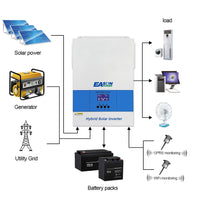Unlock the Secrets to Choosing the Perfect Solar Panel Battery Charge Regulator!
As the world shifts towards sustainable energy sources, solar energy stands out as a frontrunner in renewable power solutions. However, to harness the full potential of solar energy, effective battery charge regulation is crucial. A solar panel battery charge regulator serves as the guardian of your batteries, ensuring they are charged efficiently while preventing overcharging and excessive discharging, which can lead to battery damage. By maintaining optimal voltage levels and protecting against fluctuations, these regulators significantly enhance battery lifespan and performance. This article aims to guide you through the essential aspects of selecting the best solar panel battery charge regulator, ensuring that your solar energy system operates at its peak efficiency.

Understanding Solar Panel Battery Charge Regulators
A solar panel battery charge regulator is a vital component in any solar energy setup. Its primary purpose is to manage the flow of electricity from solar panels to batteries and loads, ensuring that batteries are charged properly without the risk of damage. There are two main types of charge regulators: Pulse Width Modulation (PWM) and Maximum Power Point Tracking (MPPT). PWM regulators are simpler and generally more affordable, functioning by switching the solar panel output on and off to maintain battery voltage. In contrast, MPPT regulators are more advanced, optimizing the energy harvested from solar panels by adjusting the electrical load to maximize efficiency. This makes them particularly effective in varying weather conditions or when using panels with different voltage outputs. Understanding these types helps users make informed choices about which regulator best suits their solar energy needs.
Key Features to Consider When Choosing a Charge Regulator
When selecting a solar panel battery charge regulator, it’s essential to consider several key features that impact performance. First, voltage compatibility is critical; ensure the regulator can handle the voltage output of your solar panels and the voltage required by your batteries. Next, load control options are important for managing how energy is distributed to your devices or appliances. Efficiency ratings, such as the percentage of energy loss during the charging process, can also affect overall performance and savings. Additionally, monitoring capabilities allow you to keep track of battery status and energy production, providing insights to optimize your system. Each of these features plays a significant role in enhancing the performance and longevity of your solar energy setup, making them essential considerations when evaluating different charge regulators.
Comparative Analysis of Charge Regulators
There are various types of solar panel battery charge regulators, each suited for specific applications. For residential setups, PWM regulators may be adequate, offering a cost-effective solution for standard solar systems. However, for users with larger solar arrays or those living in areas with inconsistent sunlight, MPPT regulators are often recommended due to their superior efficiency and ability to extract maximum energy from solar panels. In the RV and marine sectors, compact and lightweight regulators are preferred, with some models designed specifically for mobile use. While PWM regulators tend to be less expensive, MPPT models justify their higher cost with enhanced performance, particularly in challenging conditions. Understanding the pros and cons of each type based on efficiency, cost, and user experiences can help you choose the most suitable option for your solar application.
Expert Recommendations and Best Practices
Experts recommend evaluating your specific energy needs and usage patterns when selecting a solar panel battery charge regulator. Consider factors such as total energy consumption, battery capacity, and the type of solar panels you have installed. Installation should be carried out following manufacturer guidelines to ensure safety and optimal performance. Regular maintenance, including checking connections and cleaning terminals, can significantly prolong the life of both the regulator and the batteries. Additionally, utilizing monitoring tools can help you track performance and make adjustments as needed, ultimately leading to better energy management and efficiency. By following these expert recommendations, you can maximize the performance of your solar energy system and enjoy the benefits of renewable energy.
Maximizing Efficiency with the Right Charge Regulator
Choosing the right solar panel battery charge regulator is essential for maximizing the efficiency of your solar energy system. By understanding the various types of regulators, their key features, and the specific needs of your setup, you can make an informed decision that enhances battery life and overall system performance. Take the time to assess your requirements and the available options carefully; a well-chosen charge regulator can significantly impact your solar energy experience, ensuring that you harness the full power of the sun effectively and sustainably.






